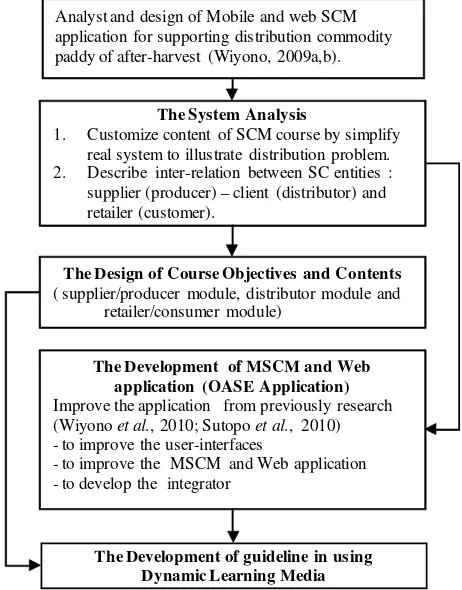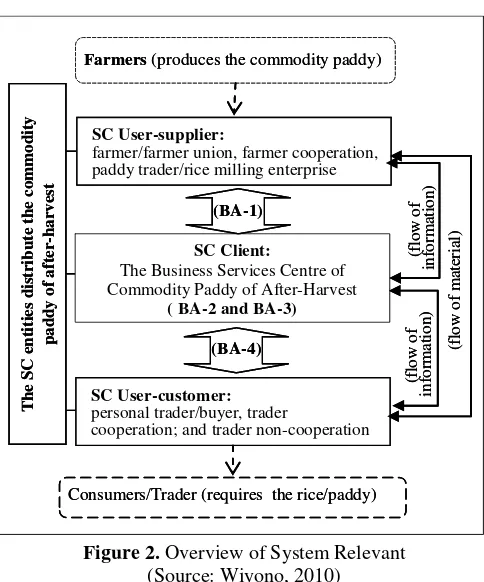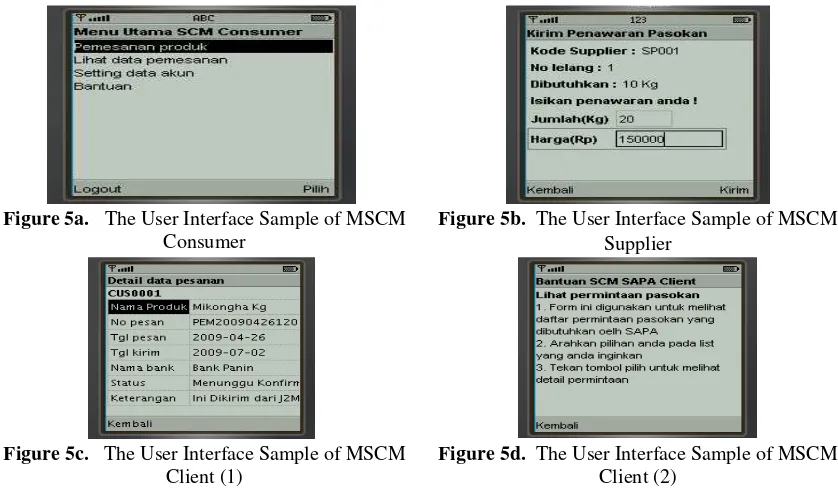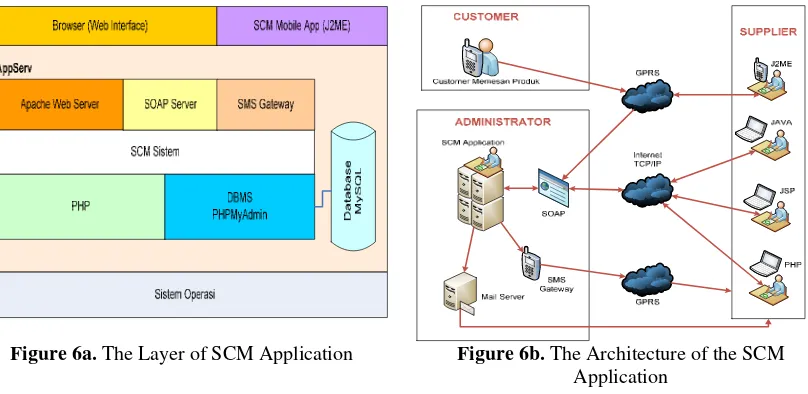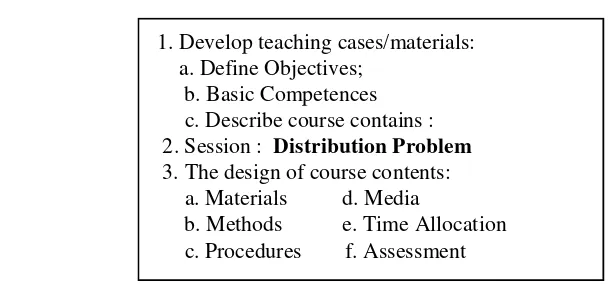Dynamic Learning Media to Improve the Pedagogic
Experience in Conveying of SCM Course
1)
Didiek Sri Wiyono∗, 2)Muh. Chaula Maliki, 2)Bayu Putra, 3)Wahyudi Sutopo 1)
Department of Informatics Engineering, Sebelas Maret University
2)
Alumnus of Dept.of Computer Science, Sebelas Maret University
3) Department of Industrial Engineering, Sebelas Maret University
Jalan Ir. Sutami No. 36A, Kentingan, Surakarta 57126
Abstract
This paper presents the application of free/open source software (FOSS) for developing educational tools in Supply Chain Management (SCM) course. There were abundant educational tools based FOSS applications. However, lecturer still faces problems to implement such an learning media for improving the pedagogic experience i.e. customizing of software function, developing of a specific educational media, and illustrating of a SCM course content. The purpose of this research is to design dynamic learning media for increasing efficiency in conveying subject matter of SCM course. We combine the mobile and/or web devices with FOSS of web service to design dynamic learning media. It has a module of real distribution problem in commodity paddy was captured. We design an interactive Web-based and Mobile-based application by using WSDL, PHP and My SQL, and SOAP. The result of the research-Mobile & Web SCM application as dynamic learning media- will be able to improve the pedagogic experience to students.
Keywords: Educational tool, FOSS, dynamic learning media, SCM course, the pedagogic approach.
1. Introduction
Supply Chain Management (SCM) is the integration of key business processes from end user through original suppliers that provides products, services, and information that add value
for customers and other stakeholders (Lambert and Cooper, 2001;Chopra and Meindl, 2004).
The development of ICTs encourages Supply Chain (SC) entities (from supplier’s supplier to customer’s customer) changes to improve the competitiveness of the company; from efforts of internal efficiency towards inter-entities collaboration for leveraging benefits to achieve
(Matopoulos et al., 2007). The SCM is one of courses should be studied by students in the
Department of Industrial Engineering/Department of Informatics Engineering, Sebelas Maret
University (Sriwiyono et al., 2010; Sutopo et al., 2010). Therefore, the students have limited
pedagogic experience when they got lesson by using static learning media. We still have no the dynamic learning media to improve the pedagogic experience in conveying of SCM course. To convey messages effectively, a lecturer should not only prepare the best course objectives and contents but also provide a teaching tool and innovative approache (Johnson and Pyke, 1999;
Hisjam et al., 2009). Learning tool or educational tool is a tool to deliver the message of
learning (Bovee, 1997).
Free/Open Source Software (FOSS) is application that is made available along with source code as a distinctive feature (Tong, 2004). FOSS applications can be used for making ICTs as dynamic learning media in limited budget (Tong, 2004; Abel, 2006). Recent advances in mobile and/or web devices can provide an easily accessible multimedia channel for dynamic learning media (Özcan and Akarun, 2002; Chu et al., 1999; Potdar and Gramoll, 2000). Therefore, for the learning process of SC course needs innovative teaching and learning methods to improve the ability of our students to solve complex problems. A good educational
tool can activate learner in analytical, computational, and experimental practices of a course. This study aimed to design dynamic learning media for increasing efficiency in conveying subject matter of SCM course.
This paper is organized as follows. In Section 1, we propose the background of our research. In Section 2, we provide the methodology for developing dynamic learning media. In Section 3, we design the interactive web-based and mobile-based applications for blending face-to-face and distance learning model. Section 4 is summarizes and future research.
2. The Methodology for Developing Dynamic Learning Media
We proposed both Mobile & Web SCM application as dynamic learning medias so that the inter-relation among SC entities can be conveyed, realized, learned, and experienced by the students. The phenomenon problem was solved using four stages as shown in Fig. 1.
The System Analysis
1. Customize content of SCM course by simplify real system to illustrate distribution problem. 2. Describe inter-relation between SC entities : supplier (producer) – client (distributor) and retailer (customer).
Analyst and design of Mobile and web SCM application for supporting distribution commodity paddy of after-harvest (Wiyono, 2009a,b).
The Design of Course Objectives and Contents ( supplier/producer module, distributor module and
retailer/consumer module)
The Development of guideline in using Dynamic Learning Media The Development of MSCM and Web
application (OASE Application) Improve the application from previously research (Wiyono et al., 2010; Sutopo et al., 2010) - to improve the user-interfaces
- to improve the MSCM and Web application - to develop the integrator
Figure 1. The Development of Dynamic Learning Media
We customize the content of the SCM course by simplify the real system to illustrate distribution problem and to describe inter-relation between SC entities (supplier/producer, distributor and retailer/consumer). The design of course objectives and contents are aimed to
produce lecturer notes, i.e. for supplier/producer modules, distributor module and
retailer/consumer modules. Then, the previous application developed by Sriwiyono (2010) and Sutopo (2010) will be customized as dynamic learning media. For implementing learning media, we should propose the guidance for learning.
3.
The Dynamic Learning MediaWe propose three steps for designing the dynamic learning media in SCM course, i.e. the
system analysis, the design of course objectives and contents, and the development of
application.The relevant system illustrated the relationship among structural aspect, functional
Farmers(produces the commodity paddy)
The Business Services Centre of Commodity Paddy of After-Harvest
The Business Services Centre of Commodity Paddy of After-Harvest
Figure 2. Overview of System Relevant (Source: Wiyono, 2010)
The concept of Kopczak and Fransoo (2000) in teaching Supply Chain Management was adopted to shorten the scope of business activities in distribution problem. The main problem simulated consists of four business activities (BA) as follows: order consolidation/planning (BA-1), receiving/record keeping (BA-2), inventory management (BA-3), and distribution planning (BA-4).
We propose the design of course objectives and contents based on previously researches (Felder and Brent, 2003) to integrate the proposed learning media into the curriculum of SCM course (Fig. 3). The lecturers should have the opportunity to have the tools they need at their fingertips. On the other hand, the new pedagogic approach must include in-dept instruction to accomplish the integration of distribution problem using appropriate analytical, computational, and experimental practices.
1. Advance practice from MSCM-case study
2. Transfer knowledge between Practitioner and academia 3. Identification of SCM issues or problems
4. Develop course notes from Problem-based Learning
Materials
5. Develop teaching cases/materials:
a. Define Objectives; b. Basic Competences c. Describe course contains :
Session 11/03 -Distribution Problem
Methods
Media Assessment
Procedures
Time Allocation
We improve the application from previously research (Wiyono et al., 2010; Sutopo et
al., 2010) to customize the user-interfaces, to finalize the application and to develop the
integrator. The design system consist of 3 steps as follow: to design model application, design database and interface. The web interfaces developed in PHP, which has five layers as follow: mobile application, SOAP server, WSDL, database and operating system. The MSCM application is implemented by two sides, that is the client side and the server side (Fig. 4).
Figure 4a. The Layer of MSCM Application
Figure 4b. The SCM-Server Architecture
Figure 4c. The SCM-Client Architecture
The MSCM application requires peripheral of mobile FOSS for supporting application with minimum requirement as follow: (i) java application by minimum version of MIDP 2.0 CLDC and 1.1 and able to connect GPRS or super ordinate; (ii) the technology of J2Me ( Java 2 Micro Edition), and (iii) The technology of JAX-RPC and protocol HTTP for connecting the data-interchange among the mobile application with the web server.
This application requires the operating system of Ubuntu 8.10 (www.edubuntu.org), the Hector and K9Web Protection/IDEA (Netbeans 6.5.1 and Eclipse Ganymede), and the tools (WTK 2.5.2, Eclipseme, LAMPP-MYSQL and of PHP, SOAP). The mobile phone mush be used for supporting the technology of Java with MIDP 2.0 and CLDC 1.1. The web service is modified to integrate the new pedagogical components consist of the students, the lecturer notes, the learning media (mobile phones for every entities and personal computer for instructor). Then, the model of MSCM can simulate distribution problem by providing the appropriate information for all SC enties (farmer, farmer union, farmer cooperation, paddy trader, rice milling enterprise, personal trader, buyer, trader cooperation; and trader non-cooperation). The resulth from the model of MSCM is as illustrated in Fig. 5
Figure 5a. The User Interface Sample of MSCM Consumer
Figure 5b. The User Interface Sample of MSCM Supplier
Figure 5c. The User Interface Sample of MSCM Client (1)
The web-based application developed using free open source software which is WSDL, Object Oriented programming method with PHP and MySQL PHP, and Simple Object Access Protocol (SOAP). WSDL interface (web service definition language) was used to communicate information between different platforms that owned by each entity in the SCM through the HTTP protocol (Fig. 6).
Figure 6a. The Layer of SCM Application Figure 6b. The Architecture of the SCM
Application
The web-based application developed using free open source software which is WSDL, Object Oriented programming method with PHP and MySQL PHP, and Simple Object Access Protocol (SOAP). WSDL interface (web service definition language) was used to communicate information between different platforms that owned by each entity in the SCM through the HTTP protocol. The prototype of OASE (Open Application for SCM course Education) is consist of five interfaces for visitor, administrator, supplier, customer and system management. Web Server was developed by using OS Linux Slackware, Apache 2.0 Web Server and Web Traffic Tools. Database Server was developed by using IBM OS and MySQL. On Client side, the PC mush has minumum requirement: OS Windows 98 or up and web browser IE versi 6.0 or Firefork versi 3. The prototype of OASE is consist of five interfaces for visitor, administrator, supplier, customer and system management. The interface can be used to input, process, and give feedback to system.The interface can be used to input, process, and give feedback to system. The samples of interface is showed in Fig. 6 and Fig. 7.
For implementing a new learning media, a good Learning Management System is necessary. A Learning Management System (LMS) is a system that provides an instructor with tools to create and deliver content, monitor student participation and assess student performance. In this paper, creating a LMS includes to achieve specified outcomes requires effort in three domains ( Fig. 7): learning objectives (identifying basic competence); designing the specified content ( modified from problem-based learning) and assessment (selecting and implementing the methods that will be used to how well the objectives have been achieved in-out classroom technique learning).
The web service as a LSM guidance GPRS
GPRS
1. The simple help guides for the system 2. A repository for online learning
materials and learner tracking 3. How to design the pedagogical
approach
4. The guidance for lecturer and students 1. The simple help guides for the system 2. A repository for online learning
materials and learner tracking 3. How to design the pedagogical
approach
4. The guidance for lecturer and students
Figure 7. The Methodology to Develop the LMS
As suggested in the LMS, the hardware requirement for implementing this teaching media is as follows:
i. personal computer with minimum specification: 800mhz intel pentium iii, 512 mb of ram,
and 750 mb of harddisk.
ii. handphone with minimum specification: java/midp programming which has GPRS and
bluetooth ( for examples: nokia e70 or nokia 6110).
iii. laptop with minimum specification: intel celeron m 1.73 ghz 512 mb.
iv. hardware server with minimum specification poweredge™ sc430.
1. Develop teaching cases/materials: a. Define Objectives;
b. Basic Competences c. Describe course contains : 2. Session : Distribution Problem 3. The design of course contents:
a. Materials d. Media
b. Methods e. Time Allocation
c. Procedures f. Assessment
Figure 8. How to design of course content
4. Conclusion and Future Research
In this paper, we introduced dynamic learning medias to improve the pedagogic experience in conveying of SCM Course. The OASE can be used to explain college students about phenomena of distribution problem as follows: order consolidation/planning; receiving/record keeping; inventory management and distribution planning. The PBL system can be held using OASE in blended learning model with learners completing an online learning module followed by a hands-on, face-to-face small group session. Furthermore, they can exercise to solve distribution problem using appropriate analytical, computational, and experimental practices. By using the proposed-learning media, the group of students can learn distribution problem anywhere, anytime, personalized learning; able to improve their literacy and numeric skills and to recognize their existing abilities; and can help to raise self-esteem for their group.
The proposed learning media has certain limitation, so as any other open source application, this application invites people around the world to complete the model. We have some works for completing this prototype as follow: testing OASE prototype, completing to all module of
SCM course and designing the experiment method to assess the student’s performance.In the
future, we expect OASE prototype to become increasingly important as e-business of learning media.
References
Abel, R.J. (2006). Best Practices in Open Source in Higher Education Study The State of Open
Source Software, The Alliance for Higher Education Competitiveness, Inc., Lake Mary, FL.
Attwell, G., Barrett S., Erkan, K., Kuru, S., Marchesi, M., Ounapuu, E. and Ulybin, O. (2005). Helping to develop an Open Source Curriculum: the case study of TOSSAS E.U. funded
project”, Proceedings of Open Source for Education in Europe, Research & Practice, pp.
157-161 (Herleen, the Netherlands, Nov. 14th-15th 2005).
Bovee, C. (1997). Business Communication Today,Prentice Hall, New York, US.
Chopra, S. and Meindl, P. (2004). Supply Chain Management: Strategy, Planning, and
Operations, 2nd Edition, Prentice Hall, New Jersey, 2004.
Chu, KC., Urbanik, N., Yip, SY. and Cheung, TW. (1999). The Benefit of Virtual Teaching to
Engineering Education. Int. J. Engineering Ed., Vol. 15, No. 5, pp. 334-338.
Felder, R. M. and Brent, R. (2003). Designing and Teaching Courses to Satisfy the ABET
Engineering Criteria, Journal of Engineering Education, Vol. 92, No. 1, pp. 7-25.
Hisjam, M., Yuniaristanto, Hakim, I.M. and Sutopo, W. (2009), Designing of ERP Application to Integrate Main Activities in A Simulator Model of SCM Network Distribution:
Manufacturer-Distributors-Retailers, Proceedings of the 2nd Asia Pacific Conference on
Johnson, M.E. and Pyke, D. (1999), A Framework for Teaching Supply Chain Management.
http://mba.tuck.dartmouth.edu/pages/faculty/dave.pyke/.../teach-supply-chain.pdf
(download: Jan 24, 2010).
Kopczak, L.R. and Fransoo, J.C. (2000), Teaching Supply Chain Management through Global
Projects with Global Project Teams. Production and Operations Management, Vol. 9, No.
1, pp.91-104.
Lambert, D.M. and Cooper, C.M. (2000), Issues in Supply Chain Management. Industrial
Marketing Management, Vol. 29, No. 1, pp. 65-83.
Matopoulos, A., Vlachopoulou, M., Manthou, V. and Manos, B. (2007). A conceptual framework for
supply chain collaboration: empirical evidence from the agri-food industry, Supply Chain
Management: An International Journal, Vol. 12, No. 3, pp.177-186.
Özcan, O.G. and Akarun, L. (2002).Teaching Interactive Media Design, International Journal
of Technology and Design Education, Vol. 19, No. 1, pp. 161–171.
Sutopo, W. Putra, B, and Wiyono, DS., (2010): An Interactive Web-based Application as
Educational Tool for SCM Course by Using FOSS, Proceedings of the International
Conference on Open Source for Higher Education (ICOSic), p.p. 55 –60, (ISBN 979-498-560-0), March 15, 2010, Surakarta, INDONESIA.
Tong, TW. “Free/Open Source Software Education”, Reed Elsevier India Private Limited, New Delhi, Hindia, 2004.
Wiyono, DS., Maliki, MC., dan Sutopo, W. (2010). Designing MSCM Application by Using FOSS to Improve the Pedagogic Approach for Learning Distribution Problem,
